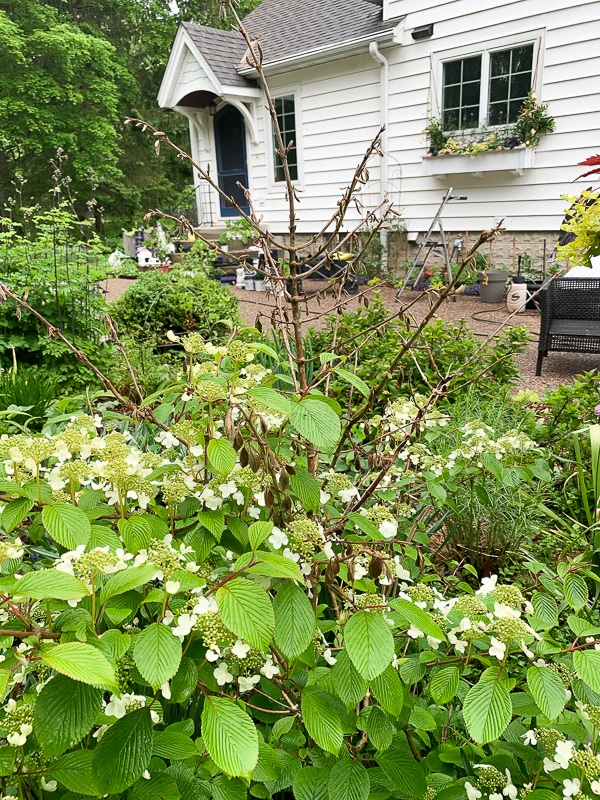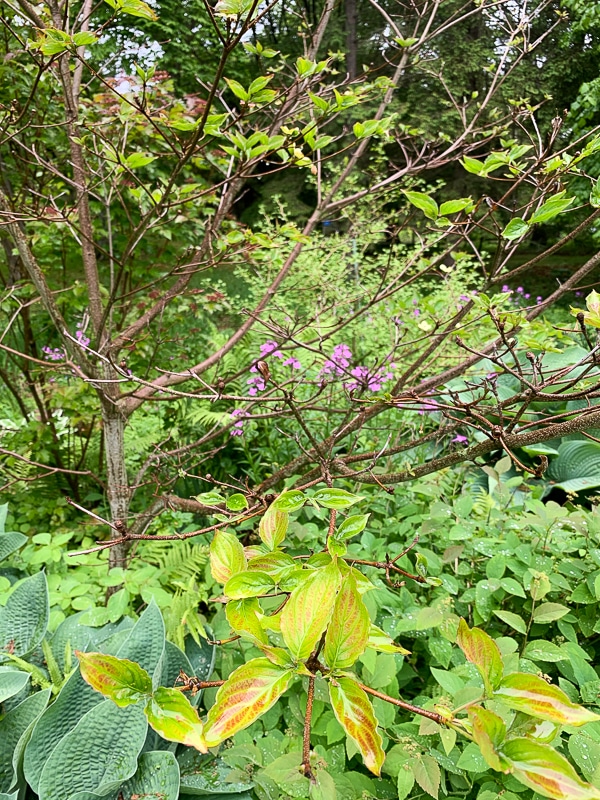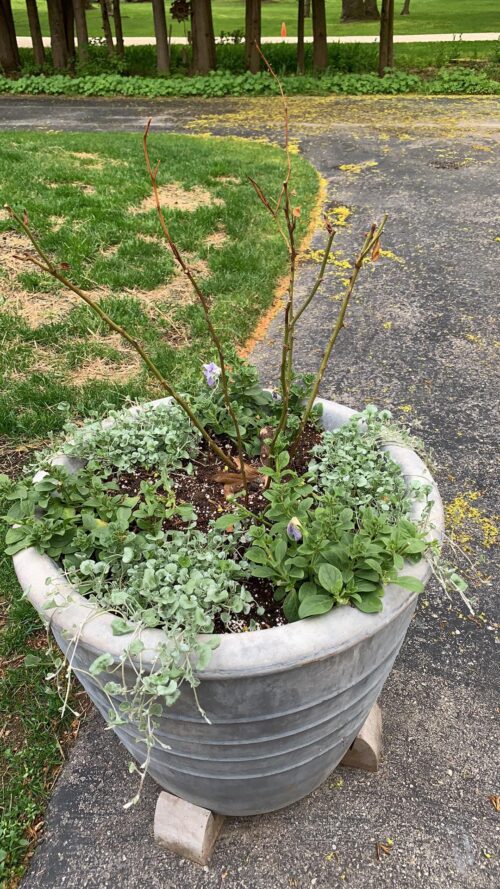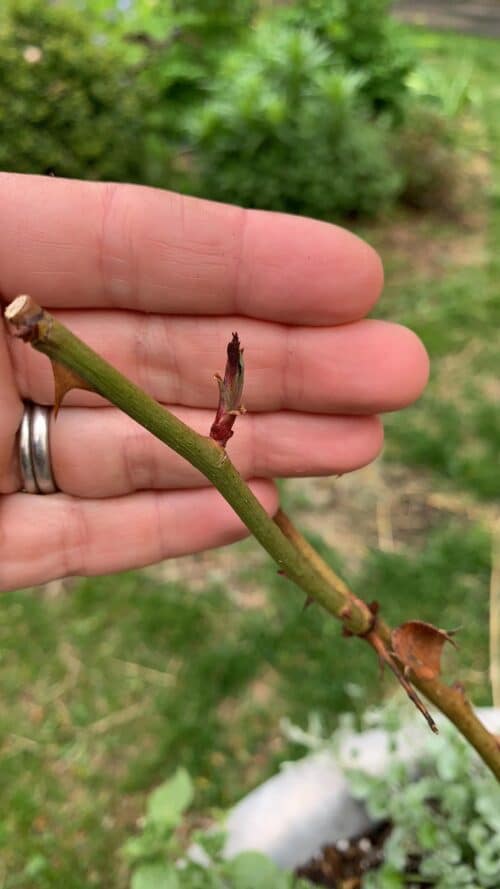The effects of our extreme winter are still showing up in the garden. With the cool, wet spring we’ve had (as much a blessing for a busy gardener who is thankful that the weeds aren’t head-high as it is a curse), everything is slower than usual. In fact I estimate that most things are still two weeks behind what I would consider normal for the garden (a moving target if there ever was one).
Still, there’s no comparison to the plant losses I suffered after the winter of 2017-2018, which had a warm spell followed by a very cold spell and some very wet and cold weather (I can’t think of a single plant that appreciates being cold and sodden simultaneously).
Viburnums
Sadly, one of the main shrubs affected by this most recent winter, which was marked by zone 4 (possibly even zone 3) cold temperatures, were my Viburnum plicatas. All three of them in my yard are suffering from botrytis, a fungus that tends to affect plants that are already stressed. I think it’s safe to say that, given that all were healthy going into winter, the stress they suffered was at the hand of Old Man Winter.

Fortunately they each lost just branches, rather than the entire plant as was the case a few years ago with my ‘Summer Snowflake’ Viburnum. I am going to baby them all a little this year to hopefully send them into winter strong.
Tough year for trees
A few days ago I was ready to declare the Chionanthus virginicus (aka white fringe tree) finally dead, but it is finally showing signs of life. Originally planted in front of the deck, I got irritated with it for being spindly and taking too long to leaf out in spring so I moved it. It’s nothing special and hasn’t really done any better in its new location, but at least it appears to be alive.
I’m not surprised to see that the Cornus hybrid ‘Venus’ (dogwood) is struggling a bit. When I bought it several years ago it was sold to me as a zone 6 plant. Hopefully it will perk up a bit this summer.

Disaster for roses
Perhaps the most profound loss was of every single rose—five this year—I wintered in containers in the garage. I’ve been successfully using this method for several years, but I think this year, even in the garage (which is unheated) it was just too darn cold for zone 5 plants in containers.
Oddly, all of the roses showed signs of life at first, with swelling leaf buds and pliable stems. All were slowly brought outside and protected with some row cover, but all have ceased any progress. It’s a big loss that has me rethinking how I overwinter roses in containers. All of the roses I grew in the ground managed OK, by the way.


There are other plants that have disappeared, so far at least, but I’m not willing to put all the blame on winter. Sometimes these things happen.
Although I’m fully in favor of waiting a plant out just to make sure that it is well and truly dead (as the Munchkins say) before declaring it compost, it’s a bummer when that realization doesn’t come until June. Most garden centers and online nurseries are sold out of the best plants, so it is at least a year of staring at what once was before there’s an opportunity for the only really good part of plant death: a new replacement.


9 Responses
My Chicago Hardy Fig I thought was never going to break dormancy, but if finally did, just after I bought its replacement. It was kept in an attached, unheated garage here in zone 5 IL. Never had and issue with it before, and it is in a good size pot. My Acer griseum I also thought would never break dormancy, and that one I’ve had before I even bought my house, I wanted on that bad. It has growth at the top of the branches, and along the stem and bits and pieces all over, but not solidly leaved out. The other one that took it very hard was the Japanese Snowbell, Styrax japonicus. It also started to leaf out, but then all our rain I think finally finished it off. I’ve been advoiding making the decision between cutting it down, waiting longer to see if it will try leaving out again, or keeping it up this year, and growing an annual climber thought it. Likely #3. It nearly died once before, and came back. But this year may just be just too, too much. Lastly, my Acer Orangeola took it on the chin, and most of it’s lower branches died. I pruned it back to where I thought was live tissue, but it looks like it isn’t going to break from those areas. Sigh….. My question is for those plants alive, but took it on the chin, how are you treating them so that they might come through next winter ok? Maybe I should cut my losses (and trees) now?
I lost two caryopteris, which are sensitive anyway, two grasses…..and a tall phlox. Thinking about trying something new in a few of those spots! Opportunity knocks, right?…..I also allllmooost gave up on a crepe myrtle I planted last year. I thought it was a goner, but it took until the beginning of June to show growth at the base! Woo hoo! My husband was bewildered a bit at my happiness! I am in SW Ohio, zone 6a so I am hoping the crepe myrtle will establish well this year. Reminds my husband of his southern roots. If it can withstand last winter as a new plant, it should be good?!?!? Here’s hoping.
As I was saying to Helen, all is slow to get going here this year. The rabbits have been eating plants. It is so frustrating. They ate one rose to the ground and then when it started to grow they ate it to the ground again. I didn’t think it would recover again but dug it up and put it into a pot just in case. I have had the rose for 30 years. It is a Carpet Rose nothing extremely special but geez, I have had it so long I didn’t want to lose it like this.
With one notable exception I’ve been fortunate. Everything in my zone 5 unheated garage survived, though unlike yours mine is attached. Pots buried in the leaf pile also survived including one I didn’t find until last week. My big loss was the big leaf rhododendron. The lower branches which were buried in the snow are fine, above that it’s damaged but will probably recover. The top 3 feet is dead so I’m reading up on rejuvenation pruning.
That’s a bummer!! I have not had any luck overwintering plants in my zone 5a unheated garage….I’m shocked you had so much luck previously with the roses. I lost 5 roses in the ground last winter, and this winter I think I may have lost a clematis, I definitely lost a blueberry bush and my black currant bush, and my climbing roses are starting all over again from the ground up. All the canes on the arbor are dead as doornails.
I lost my small Fringe Tree to too many Arctic vortexes, a bomb cyclone, and a few late blizzards and frosts thrown in for good measure. ? It is coming from the roots but won’t amount to anything… just a darn tough winter in the Midwest. I was actually amazed at how many things didn’t seem fazed by it!
Everything has been so slow to revive here in central Indiana. I finally gave up on two ornamental grasses planted last year to cover utilities. I just bought new ones. Everyday, I find plants coming up that I thought were lost during the winter. Some of them, I forgot I had planted them.
Hi Helen, I live in SW Indiana and I am noticing some of the same happening here. Everything is slow to come out.
I planed a new fringe tree last year and I thought it might be dead as well, but I waited and it looks wonderful now and has put on a ton of new growth!!!! I’m in Michigan zone 5, really cool wet spring here as well.